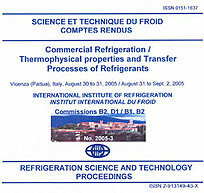
Document IIF
Analyse théorique des pressions de fonctionnement et d'arrêt d'un système de conditionnement d'air transcritique au CO2.
Theoretical analysis of the operating and shutdown pressures of a transcritical carbon dioxide air conditioning system.
Auteurs : LI D., GROLL E. A.
Résumé
A theoretical analysis of the sensitivity of the system charge on the operating and shutdown pressures of a transcritical CO2 air-conditioning system was performed. The sensitivity of the system charge on shipping pressures was also evaluated. The unit to be considered is an air-to-air air conditioning system with a cooling capacity of 10.3 kW. The nominal charge is based on low and high side normal operating pressures of 40 and 110 bars, respectively, at standard DOE A operating conditions. The refrigeration unit is self contained, such as the US Army ECU (Environmental Control Unit). The operating and shutdown pressures were determined assuming a 5, 10 and 20% overcharge. The operating pressures were determined at standard DOE A operating conditions. The shutdown pressures were determined at 26.7 and 43.3 °C ambient temperatures. To evaluate the sensitivity of system charge on shipping pressures of the same unit with the nominal charge of CO2, the internal shutdown pressure was determined in a 70 °C boxcar environment.
Documents disponibles
Format PDF
Pages : 2005-3
Disponible
Prix public
20 €
Prix membre*
Gratuit
* meilleur tarif applicable selon le type d'adhésion (voir le détail des avantages des adhésions individuelles et collectives)
Détails
- Titre original : Theoretical analysis of the operating and shutdown pressures of a transcritical carbon dioxide air conditioning system.
- Identifiant de la fiche : 2006-0614
- Langues : Anglais
- Source : Commercial Refrigeration. Thermophysical Properties and Transfer Processes of Refrigerants. Proceedings of the IIR International Conferences.
- Date d'édition : 02/08/2005
Liens
Voir d'autres communications du même compte rendu (140)
Voir le compte rendu de la conférence
Indexation
-
Thèmes :
Compresseurs;
CO2 - Mots-clés : Système frigorifique; Système à compression; Pression; Experimentation; Cycle transcritique; Charge en frigorigène; CO2
-
On the optimum interstage parameters for CO2 tr...
- Auteurs : MANOLE D.
- Date : 29/05/2006
- Langues : Anglais
- Source : 7th IIR-Gustav Lorentzen Conference on Natural Working Fluids (GL2006). Proceedings
- Formats : PDF
Voir la fiche
-
Challenges on the development of a CO2 compress...
- Auteurs : BOSCO R., WEBER G.
- Date : 07/09/2008
- Langues : Anglais
- Source : 8th IIR-Gustav Lorentzen Conference on Natural Working Fluids (GL2008)
- Formats : PDF
Voir la fiche
-
Experimental investigation of the CO2 refrigera...
- Auteurs : HWANG Y., RADERMACHER R.
- Date : 1999
- Langues : Anglais
- Source : ASHRAE Transactions. 1999 Winter Meeting, Chicago, Illinois + CD-ROM.
Voir la fiche
-
CO2-expander/compressor for subcritical and tra...
- Auteurs : RIHA J., QUACK H., NICKL J.
- Date : 27/09/2006
- Langues : Anglais
- Source : Compressors 2006: 6th International Conference on Compressors and Coolants
- Formats : PDF
Voir la fiche
-
Refrigerant capacity ratio as an indicator to e...
- Auteurs : CLODIC D., PALANDRE L.
- Date : 26/08/2002
- Langues : Anglais
- Formats : PDF
Voir la fiche
